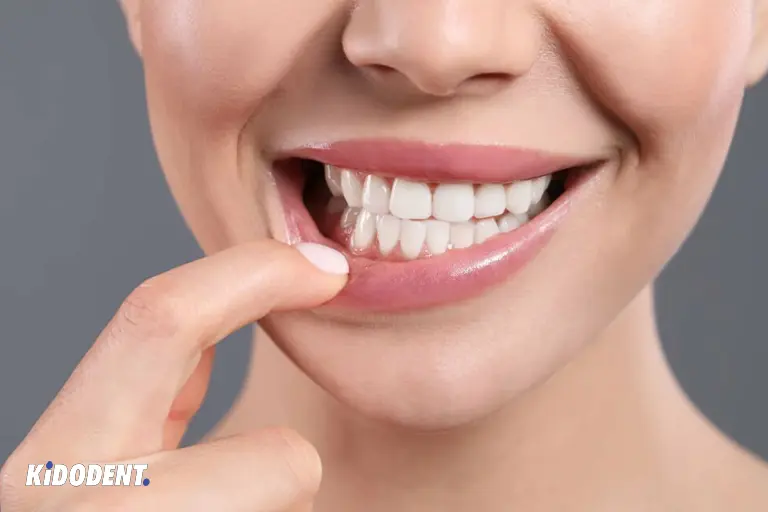Once tooth roots are exposed, we most likely feel sensitivity and pain. Teeth are susceptible to bacteria attacks and are more prone to decay. The most common causes are periodontal and gum diseases. It causes gums to recede and leave gum line a gap for plaque buildup on teeth and bacterial activity. However, other factors can contribute to exposing the tooth roots like long-time aggressive brushing and wear and tear.
What is an exposed tooth root?
Every tooth in our mouth consists of a crown (the upper part) and roots. The upper part of a tooth or crown is covered by the enamel, the hard outer layer of tooth structure. However, the roots of a tooth are covered by cementum, which is thinner than enamel. What we mean by the exposed tooth root is when gum recedes back and some parts of the cementum or enamel will be unprotected by the gums.
The exposed roots if not treated will begin to decay and erode due to foods, dental plaque, and other bacterial activity in the mouth.
Symptoms of exposed tooth root
Teeth sensitivity can be one of the early signs when roots are being exposed. Also, the most common symptom is receding gums. Your teeth appear longer and gums receded in the junction between teeth and gums.
You will have teeth sensitivity particularly to any triggering factor such as drinking and eating hot or cold or sour and acidic foods and drinks. If the gum diseases have already existed or have caused the exposed root, you will have swollen, red, or bleeding gum symptoms.
Exposed tooth root picture
What causes exposed tooth root?
When part of your teeth is damaged, there will be plenty of chances for bacteria to colonize that area of the tooth. This is especially true for the root of a tooth. If the enamel that covers the root is damaged, the dentin which is the underlying structure will be exposed. Then bacteria have a greater chance to infect dentin and finally damage the pulp of your teeth. This is when you can feel sensitivity by hot or cold foods and drinks.
The causes of the exposed tooth root are:
- Poor oral hygiene
- Tooth decay
- Gum recession
- Periodontal disease and other gum diseases like gingivitis
- Aggressive toothbrushing, often due to harsh-bristle use and brushing with great force
- Smoking and tobacco use
- Trauma and hard injuries to teeth
What are the risks?
When the root of your teeth is exposed, it results in tooth decay. If left untreated, tooth loss is expected. The damage is caused by plaque buildup and the microorganisms that are present in your saliva and foods. Common risks include:
- Tooth sensitivity
- Faster tooth decay due to loss of enamel in this area
- Tooth loss
- Gum diseases and severe gum problems like periodontitis
- Damages to the pulp
Treatment
Brushing with fluoride toothpaste daily is the best way to protect our teeth. Over time, fluoride will strengthen the structure of the teeth whether the roots or the surface of our teeth. However, your dentist can recommend fluoride varnish treatment where a higher concentration of fluoride and different peroxide formula can be applied to your teeth.
According to a study by Lazarchik and Haywood published in The Journal of the American Dental Association (2010), the use of custom-fitted trays with 10% carbamide peroxide gel will prevent decay risks and is a recommended treatment to treat tooth decay to stop more damage to teeth.
Dentists can also perform dental prophylaxis, which includes a series of plaque removal, scaling, stain removal, and other teeth cleaning procedures, to gain control of the tooth’s health. Prophylaxis will recover the gum health and can destroy bacterial activity in both exposed and hidden surfaces of the teeth in your gum line.
Sometimes, your dentist may need to repair an exposed tooth root to a normal condition. Dentists can use dental bonding composite resin to restore and prevent further exposure of the root to bacteria and other harmful impacts.
Finally, if there is a need for gum enhancement because of receding gum, which has caused the roots to be exposed, your dentist can recommend a gum grafting procedure.
How to prevent exposed tooth root?
If you have the routine habit of oral hygiene tasks, keep on doing and take good care of your teeth and gums even more. It all starts with poor oral hygiene. For the prevention of exposed tooth root, you can take more necessary steps:
- Brush teeth twice a day with fluoride toothpaste
- Brush your teeth gently with a soft-bristled toothbrush
- Floss your teeth to get rid of any food debris
- Do not forget to clean between the teeth and gums (gum line)
- Avoid using foods and drinks high in sugar
- Avoid acidic fruits and drinks
